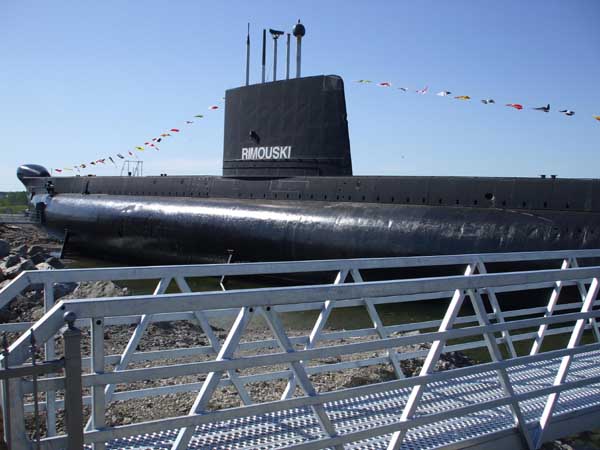 |
| June 2009: Onondaga as she appears as a museum submarine. (Photo by Don Courcy) |
ONONDAGAIn 2005, it was announced that the now paid-off Oberons were to be sold for scrapping, as they had deteriorated beyond the point of any further use. Three of the four surviving boats were laid up at CFB Halifax as of December 2008 awaiting disposal. The fourth submarine, Onondaga, was purchased for C$4 plus tax by the Site Historique Maritime de la Pointe-au-Père (near Rimouski, Quebec) for conversion into a museum ship and was towed from Halifax to Pointe-au-Père, Quebec in July 2008. Onondaga opened her doors to visitors in June, 2009.
 |
| June 2009: Onondaga as she appears as a museum submarine. (Photo by Don Courcy) |
OLYMPUS and OKANAGANBy mid 2011, Olympus and Okanagan were sold as scrap and were to be broken up by Marine Recovery Corporation of Port Colborne, Ontario. Both boats were dry-towed on a floating drydock from Halifax to Hamilton, then transferred to another drydock for towing to final destination. Olympus went first, then Okanagan followed.
The last voyages of Olympus and Okanagan were facilitated by two Hamilton companies, McKeil Marine and Heddle Marine Services Inc. Heddle provided a floating dry dock on which the sub was loaded while McKeil provided the tugboats that pulled the boats up the St. Lawrence River and across Lake Ontario. Moving the subs called for some careful engineering work to ensure the 1,800-ton cargo remained stable during the 10-day voyage, explained Heddle Marine president Rick Heddle. “We used enough cables and supports so that it could never topple over,” he said. “It was a case of loading it, securing it and then watching our weather.”
Every stage of the 1,200 nautical mile voyage was carefully planned to ensure the towing vessel and cargo were never too far from a safe port — a refuge they'd need should waves become higher than two metres or if the wind blew faster than 25 knots.
The subs were moved in an identical process called dry towing — a Heddle-designed dry dock was submerged under each boat then it lifted it out of the water. The alternative, a wet tow, in which a tug simply hooks onto the boat was rejected by the St. Lawrence Seaway authority. “After sitting idle for almost 10 years, these boats are in pretty rough shape,” Heddle said. “If one was to sink in a lock that could plug up the whole Seaway system.”
Paulo Pessoa, McKeil’s vice-president for business development, said that foreign companies could have been hired to move and cut up the boats at lower costs, however hiring Canadian firms ensured the work would be done with the smallest environmental footprint. “DND had a lot at stake here,” he said. “If they hired a company to recycle the submarines and then have one sink in the river, that would be a PR disaster. Paying the extra cost associated with executing the job in the safest way possible is a no-brainer,” he added. “For us, redundancy was the name of the game.”
Olympus arrived into Hamilton Harbour on Thursday July 28 2011 .For Okanagan it was her second visit to the city of Hamilton. She was last there in November 1990 as part of a good will tour of the Great Lakes — the first such voyage by a Canadian submarine. Okanagan arrived into Hamilton Harbour on August 19 , 2011 at 2340 EDST. The final leg of the trip would be from Hamilton through the Welland Canal and into Lake Erie.
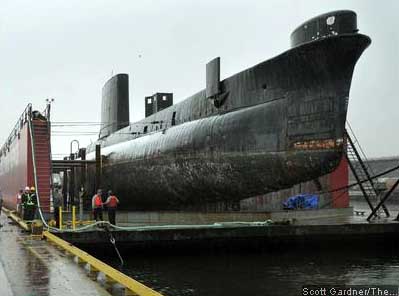 |
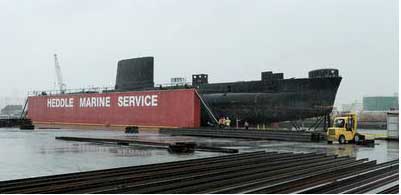 |
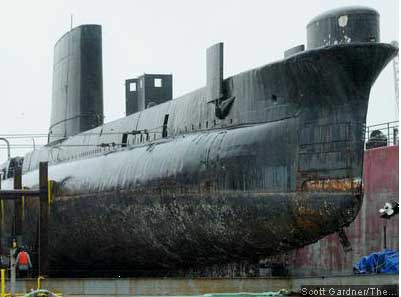 |
| The Olympus is seen docked in Hamilton Harbour at Heddle Marine Services Inc. on July 28, 2011 |
| All photos by Scott Gardner, The Hamilton Spectator |
 |
| This is one of the "No-Thrust Wheels" fitted on Olympus. It is basically a water wheel with a ring around the outside. When rotating, it placed a load on the motor/generator/diesel but produced no thrust whatsoever. This was an ideal arrangement for training engine room crew since Olympus was a training sub only and remained alongside the jetty at all times. Here, the retired sub is passing through the Welland Canal around September 15/11. (Photo by Jim Brewer) |
 |
| Okanagan in Halifax on August 11, 2011. She has just been fully rigged for her voyage to Hamilton. Floating drydock HM1 and Okanagan were pulled and pushed by the tugs TONY MACKAY and MOLLY M 1. (Photo by Kenneth Watson) |
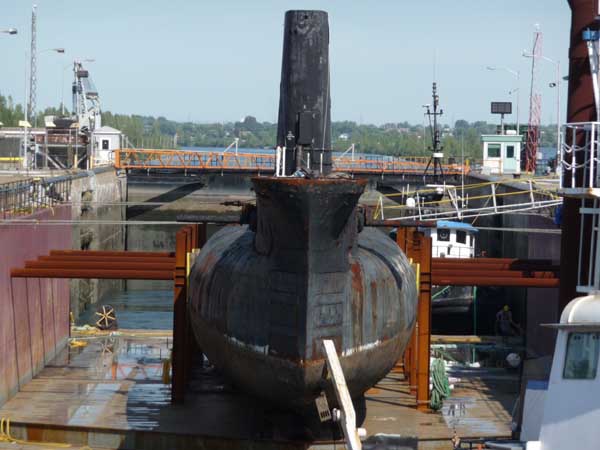 |
| Above and below. Okanagan is clearing the St. Catherine lock on the St. Lawrence Seaway on Aug 17, 2011. (Photos by Dwayne Hill) |
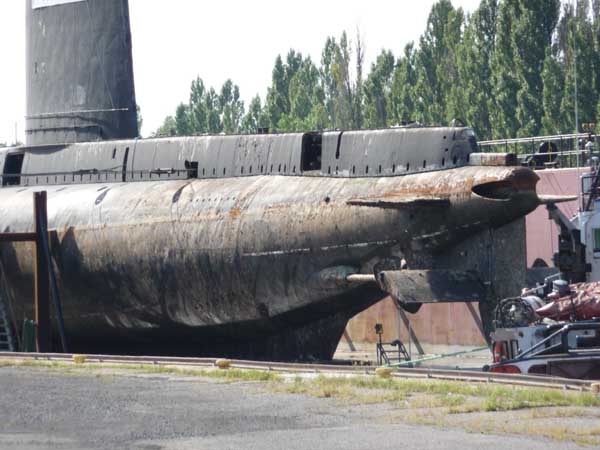 |
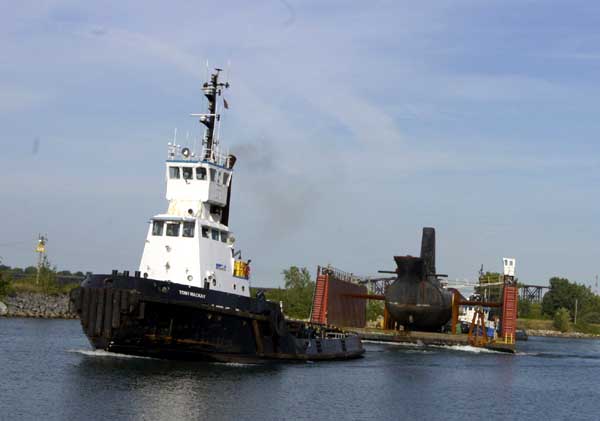 |
| OKANAGAN passes through the Kahnawake Mohawk reserve on August 17, 2011. She is being towed by the Tony Mackay. She cleared the Welland Canal around September 22, 2011. (Photo by Kent Malo) |
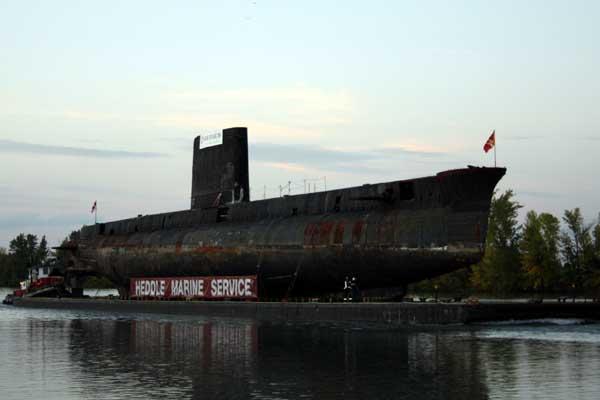 |
| Above and below: Okanagan's final journey to the breaker's yard at Port Maitland. These photos were taken below Lock 2 on the Welland Canal on Sept 22, 2011. (Photo by Ian Baker VE3OZN) |
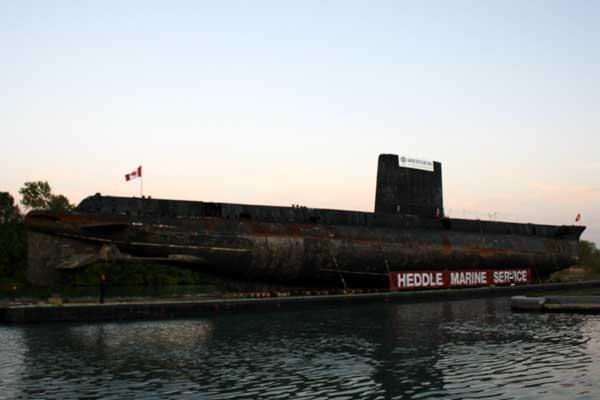 |
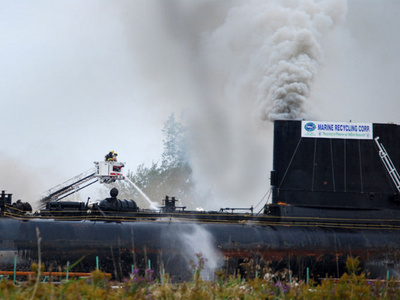 |
| Firefighters battle the blaze aboard Olympus. (Photo courtesy Design House/Special to the Hamilton Spectator) |
On October 11, 2011 Port Maitland/Haldimand firefighters battled and unusual blaze aboard Olympus now located the yard of Marine Recycling Corp., Feeder Canal Road East near Lowbanks.The blaze started around noon inside the submarine, where workers were removing parts. A grinder was in use at the time the fire started and a stray spark may have been the culprit. No one was injured but the exact cause may never be known. Feeding the fire was cork board, which lined the inside of the pressure hull.. Firefighters from six different Haldimand fire stations spent the afternoon fighting the smoky blaze with 12 fire trucks.
OJIBWA
As of August 29 2011, the fate of Ojibwa is undecided. She is still in Halifax. Due to a standoff in government bureaucracy between two departments, she will either go to the scrap yard or will find her way to the Port Elgin Military Museum where the sub will be placed on display in Port Burwell, Ontario.A major headache for the museum is the decision about when to dredge the harbour mouth and Otter Creek to accept the drydock that carries the sub. The Project Ojibwa group doesn't want to dredge anything until the submarine is on its way. But there is also no sense dredging in the fall of 2011 if the boat won't arrive until the summer of 2012 when another costly dredge would be needed.
On 1 December 2011, The Elgin Military Museum was pleased to announce that it received a letter signed by the Honourable Peter MacKay, Minister of National Defence, that the Museum has now received “approval in principle of the donation of the Ojibwa submarine to the Elgin Military Museum” .The Museum is now moving on to Phase Two, which involves demonstrating to the Minister that the Museum has the necessary financing for the Project.
On May 16/12, the Department of National Defence signed documents which released the Ojibwa to the Elgin Military Museum. The tug Florence M was dispatched along with a floating drydock owned by Heddle Marine of Hamilton to pick up the Ojibwa in Halifax. After some preparation by Heddle Marine in Hamilton, Ojibwa
was towed through the Welland Canal and finally arrived at Port Burwell at 10:00 am on Tuesday Nov 27/12 after encountering a delay. It was originally scheduled to have arrived the week before, but ongoing dredging work at the port proved insufficient to provide clearance for the sub and the barge that carried it from Hamilton.
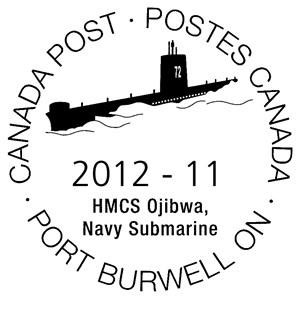 |
| Unique mark for back of mail sent from Port Burwell Post Office. (Image courtesy Canada Post) |
Canada Post created a unique method to honor the arrival of HMCS Ojibwa in Port Burwell. Starting Thursday, November 22/12 all mail sent from the Port Burwell Post Office will bear this special mark. While all mail from the Port Burwell area goes through the cancellation process in London, Ontario, this unique commemorative mark will be applied by hand to the back of all mail that is handed over the counter at the Port Burwell Post Office over the next six months.
 |
| Ojibwa has just received a coat of gray primer at the Heddle Marine facility in Hamilton. (Photo by Glen Lawson, Torstar News) |
Upon arrival in Port Burwell, Ojibwa was greeted with a one gun salute and a warm welcome from spectators lining both sides of the harbour. After being painted, she was placed on permanent display and opened her doors to the public on the weekend of June 29, 2013.
 |
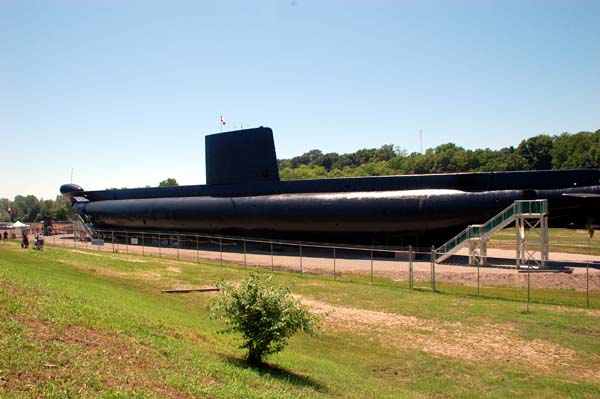 |
| Although very hard to see here, there is a rather large dent in the port side fuel tanks below and slightly ahead the fin. This came as a result of an alongside, underwater shock trial with FDU(A) in the 2003 time frame. Explosives were detonated near the fuel tanks to see what effect it would have on the sub's structure.. |
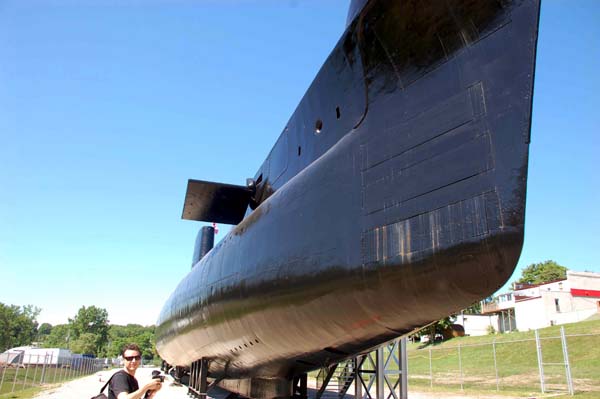 |
| Ojibwa, as seen on July 14, 2013, is now open to the public. (All photos in this table by Jerry Proc) |
PRESERVATION PROJECTWhile most of the steel from the scrapped subs will be recycled, some portions will be preserved. Marine Recovery Corporation (MRC) plans to take the tops of the submarines, including the fin, to Derek Point Memorial Gardens in Port Colborne, where they will be placed on display. The company built the park about eight years ago. It also contains nautical pieces from various Great Lakes freighters . The submarine parts will be placed to look as though one is submerging and the other surfacing. When they are put into place, MRC will also place sections of the Fraser — a Canadian designed and built St. Laurent class destroyer — in the park. The Fraser was broken up by the company in 2010.
About 100 tonnes of steel from each submarine and the destroyer will be used to create exhibits at the park which is located where the old Welland Canal meets the new Welland Canal. Once completed, likely by the summer of 2012, the exhibits will be dedicated in memory of three local business leaders, whose names have yet to be announced, as well as in honour of the Royal Canadian Navy, which celebrated its 100th anniversary in 2010.
Prior to MRC taking possession of the Okanagan and Olympus, items of historical significance were removed from the boats and donated to the Maritime Museum of the Atlantic in Halifax for preservation. DND considers all possible options when disposing of its assets. Financial, environmental and security considerations are made before an option is chosen. The department selects the most appropriate option for each asset on a case-by-case basis.
Wayne Elliott, MRC's director of business development, is pleased that MRC is able to preserve pieces of Canada's marine heritage locally. He has high hopes the park will provide joy to residents and visitors of all ages for years to come.
Contributors and Credits:1) Hamilton Spectator. Article by Steve Arnold on Friday July 29/11. http://www.thespec.com/news/business/article/570602--naval-vessel-towed-through-hamilton-en-route-to-sub-shop
2) Don Courcy <donaldcourcy(at)videotron.ca>
3) Subs Nearing End of Journey story by Maryanne Firth, Halifax Tribune
4) D.H. "Buster" Brown <retsubmarine(at)eastlink.ca>
5) Jim Brewer <snack.235(at)sympatico.ca>
6) Ian Baker VE3OZN <seawolf2(at)sympatico.ca>
7) Catherine Raven <caraven(at)sympatico.ca>July 15/13